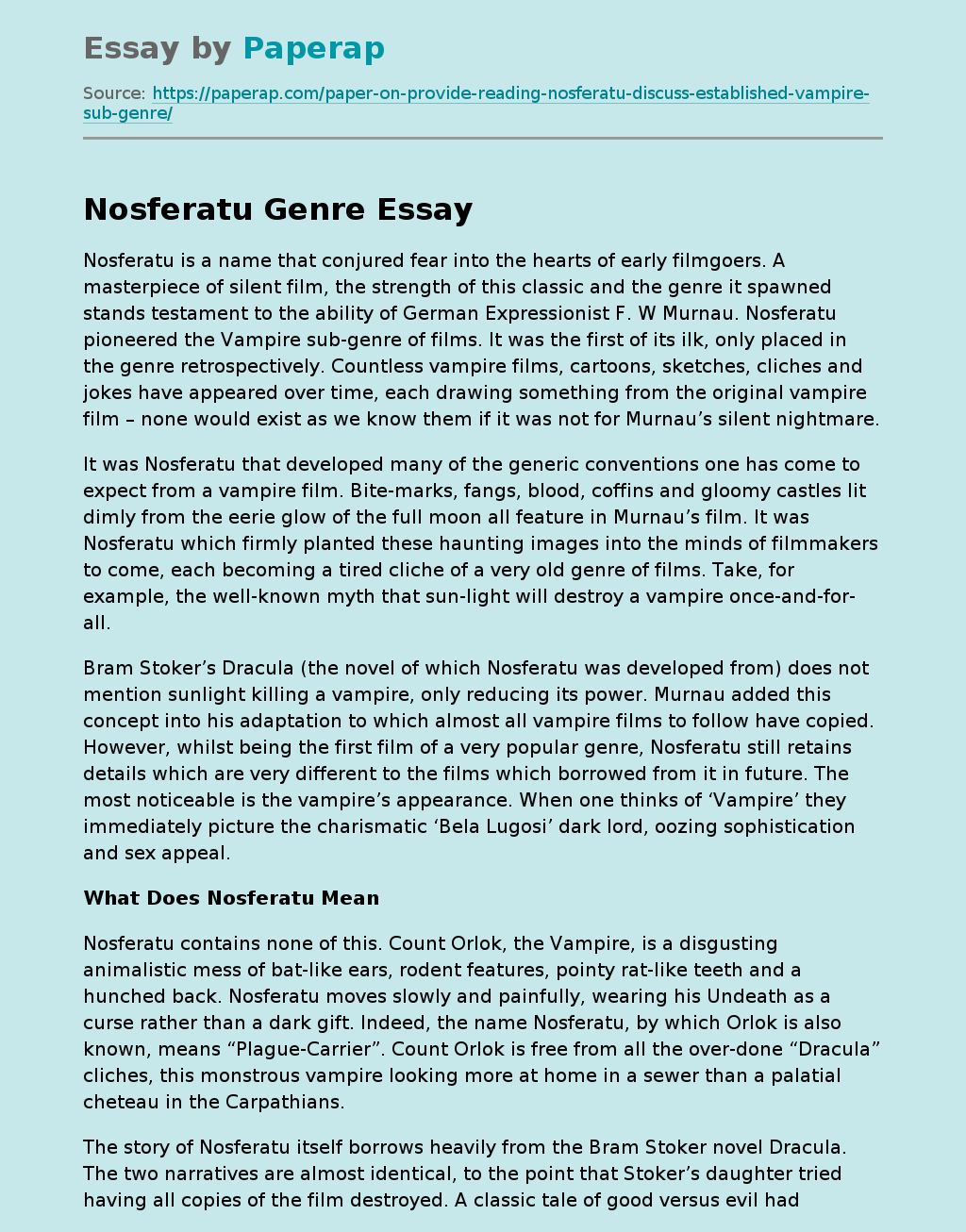What Does Nosferatu Mean
Nosferatu is a name that conjured fear into the hearts of early filmgoers. A masterpiece of silent film, the strength of this classic and the genre it spawned stands testament to the ability of German Expressionist F. W Murnau. Nosferatu pioneered the Vampire sub-genre of films.
It was the first of its ilk, only placed in the genre retrospectively. Countless vampire films, cartoons, sketches, cliches and jokes have appeared over time, each drawing something from the original vampire film – none would exist as we know them if it was not for Murnau’s silent nightmare.
It was Nosferatu that developed many of the generic conventions one has come to expect from a vampire film. Bite-marks, fangs, blood, coffins and gloomy castles lit dimly from the eerie glow of the full moon all feature in Murnau’s film. It was Nosferatu which firmly planted these haunting images into the minds of filmmakers to come, each becoming a tired cliche of a very old genre of films. Take, for example, the well-known myth that sun-light will destroy a vampire once-and-for-all.
Bram Stoker’s Dracula (the novel of which Nosferatu was developed from) does not mention sunlight killing a vampire, only reducing its power. Murnau added this concept into his adaptation to which almost all vampire films to follow have copied. However, whilst being the first film of a very popular genre, Nosferatu still retains details which are very different to the films which borrowed from it in future. The most noticeable is the vampire’s appearance.
When one thinks of ‘Vampire’ they immediately picture the charismatic ‘Bela Lugosi’ dark lord, oozing sophistication and sex appeal.
Nosferatu contains none of this. Count Orlok, the Vampire, is a disgusting animalistic mess of bat-like ears, rodent features, pointy rat-like teeth and a hunched back. Nosferatu moves slowly and painfully, wearing his Undeath as a curse rather than a dark gift. Indeed, the name Nosferatu, by which Orlok is also known, means “Plague-Carrier”. Count Orlok is free from all the over-done “Dracula” cliches, this monstrous vampire looking more at home in a sewer than a palatial cheteau in the Carpathians.
The story of Nosferatu itself borrows heavily from the Bram Stoker novel Dracula. The two narratives are almost identical, to the point that Stoker’s daughter tried having all copies of the film destroyed. A classic tale of good versus evil had a simple Equilibrium-Disequilibrium-New Equilibrium storyline. We see Hutter and Ellen happy in their married life until Hutter is drawn into the web of the vampiric Count Orlok, with the Nosferatu preying upon Hutter and his wife. However, the new-equilibrium is not a happy ending.
While Orlok dies to the rays of the morning sun, Ellen lays dead having sacrificed herself to destroy the vampire and the plague it brought with him. The film also finished with a low angle shot of Orlok’s castle… does some evil still lurk within? Has the curse of Nosferatu really been destroyed? The film is designed to make people uneasy and even the film’s resolution leaves the audience feeling unnerved rather than relieved. Murnau was a pioneer of the Expressionist movement. His film rests heavily on mood and theme rather than the character acting.
He evokes a feeling of unease through his use of lighting and shadow. He distorts and exaggerates shapes into unrealistic proportions in order to express feelings through the medium of film. For example, the actors wear heavy make up and move jerkily or slowly – exaggerated in order to express a mood. The characters do not simply exist within a setting but are visual elements that merge with the setting – Murnau tells his story through the entire mise-en-scene rather than his characters – each element of this mise-en-scene interacts and combines to create a unique mood and atmosphere.
We can see this use of mise-en scene to tell his story throughout the film. Much of the film is shot in shadow, giving a darker more haunting atmosphere to the film coupled with the iris shots, which Murnau made much use of, give a feeling of being trapped – that there is no escape from the terror that stalks Ellen and Hutter. Similarly Murnau uses detail in the entire screen, often utilising the corners, which suggest and hidden horrors lurking in the corners. Murnau also makes use of long takes, often of images of death and decay, which causes discomfort in the audience watching.
Murnau used more symbolic scenes to express the mood of the film, such as those of spiders and Venus flytraps. Its not only visual elements that add to the creation of the film’s tone, music too plays its part. Munau called it his “Symphony of Terrors” – a disjointed, discordant and unnerving noise that is not in the least bit tuneful. The music of the film is a very powerful tool in the storytelling of Nosferatu, building up suspense or shocking the audience. Each of the film’s attributes combine to create distinct ambience that doesn’t just tell the story – but lets the audience feel the story.
What Does Nosferatu Mean. (2019, Dec 05). Retrieved from https://paperap.com/paper-on-provide-reading-nosferatu-discuss-established-vampire-sub-genre/

